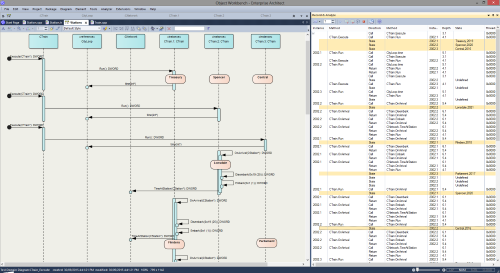


Sequence diagrams provide a very compact notation, compared to an activity diagram. It can also be noted when an agent is active or waiting for an action or input (no focus of control). The message passing can be seen among the agents and it is possible to differentiate between asynchronous and synchronous messages. In addition, the diagram type focuses on communication among agents, therefore it does not fit to describe the behavior of a single agent.Īs you see in the example above, the time dimension is in the y-axis. They are used to show typical examples of sequences, since the time dimension limits this diagram type to instance level – you cannot show alternatives, loops or parallel processing without disrupting the time dimension. Sequence Diagrams show the sequence of communication steps between agents over time. The exception to these rules is the “End of flow” or “End of Activity”. Swim lanes of Agent are useful in the case multiple agents are involved and you want to show who performs which action and which decision.Įach action should only have one single input and one single output.īranches opened by a diamond (decision) should also be closed by a diamond (merge), same is true for fork and join bars. In this case the branches are started with a fork bar and synchronized with a join bar. Sometimes you have to show parallel branches where actions are performed concurrently. Please note that a decision always requires a condition to decide which branch to take. In most cases alternative branches are used that are started at a decision diamond and end in a merge diamond. The name of an action should be short but descriptive enough to get an idea what happens.Īrrows connect the elements, indicating the logical (causal) sequence. The most important element is the action which describes what happens in one step. The example below contains most elements of an activity diagram (element names are in blue).Īll activity diagrams must have one or more “Start of Activity” and one or more “End of Activity”. TAM provides three UML diagram types to describe behavior which can be used depending on the purpose of the diagram each type will be presented in this document: Activity Diagrams:Īctivity Diagrams show the logical sequence of actions (and events) which can be observed in a system, including alternatives and parallel branches. The focus can be on describing the behavior of a single agent or the interplay among multiple agents. The description of behavior can also be called the “Dynamic Structure” of a system.
#Enterprise architecture sequence diagram how to#
The intent of this article is to present details about how to describe behavior using TAM. This blog post continues the previous posts from Bernhard Groene in part1 and part2, which were giving an overview and an introduction to TAM block diagrams. How to communicate Architecture – Technical Architecture Modeling at SAP (part 3)


 0 kommentar(er)
0 kommentar(er)
